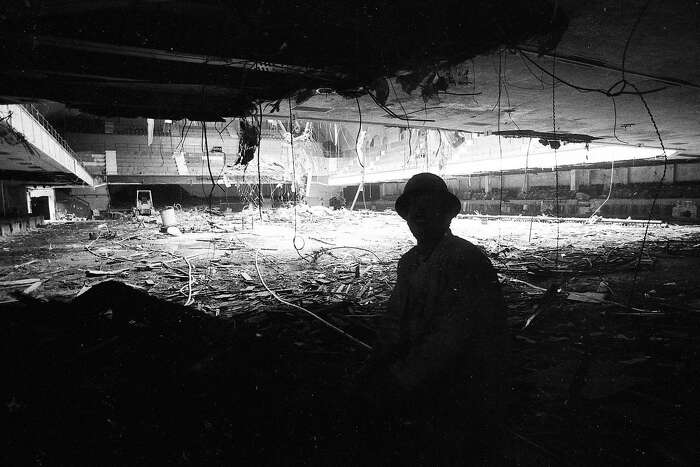This is a carousel. Use Next and Previous buttons to navigate
If it wasn’t for the wooden wall separatingKirk Hammettand the crowd before Metallica’s Oct. 12, 1991, Day on the Green performance at the Oakland Coliseum, it would be impossible to tell who was the rock star and who were the fans.
Metallica was arguably the biggest rock band in the world, just two months after the debut of “Metallica” — the “Black Album” that would go 16 times platinum. But Hammett ran below the stage bumping fists with the crowd, in his“Horror-Thon”T-shirt with classic movie monsters on the front, and a smile on his face like he was playing in a garage again.
The Chronicle story that followed focused on the violence in the mosh pits, and the damage to the Coliseum baseball field that included large chunks of grass pulled out by rowdy heavy metal fans. But time and perspective prove that the big show was a breakthrough moment for Metallica — which continues to headline local arenas, and continues to call the Bay Area home.
The color images were discovered during a search for photos to accompany an episode of “The Big Event” podcast that pays tribute to the 1988 “… and Justice for All” album. Instead, more than three dozen 1991 Day on the Green photos were found, with about half featuring the crowd and half featuring the band.
Metallica’s first advertised Bay Area performance was at the Old Waldorf in 1982, billed as “Metallica — from L.A.,” and playing with Richmond band Exodus for just $3.97. The band crystallized as a San Francisco entity on March 5, 1983, when bassist Cliff Burton played his first public Metallica gig at the Stone at 412 Broadway.
The band recorded their first three albums — “Kill ’Em All” (1983), “Ride the Lightning” (1984) and “Master of Puppets” (1986) — before the first Metallica interview appeared in The Chronicle. Drummer Lars Ulrich was alternately calculated and defiant, mocking the hard rock cliches of other bands, while insisting that Metallica’s lack of industry support early in their career was an artistic blessing.
“Over the past couple of years, we’ve had to be united on one standpoint,” Ulrich said, “so all the businesspeople couldn’t make decisions for us. And thank God for our instincts.”
“… And Justice for All,” the band’s most complex and fast-paced album yet, came out in 1988. A tour stop later that year at the Cow Palace drew a rave from The Chronicle’s Joel Selvin.
“Low on spectacle and trend-consciousness, heavy on raw energy and brutal musicality, Metallica gives a solid helping of the band’s unique artistic vision,” Selvin wrote after the Dec. 10, 1988, show. “The years of grassroots appeal clearly have paid off, allowing Metallica to reach a broad teenage audience without compromising the basic essence of what the band does.”
Metallica hadn’t yet headlined a stadium in the Bay Area. The band opened for the Sammy Hagar-led Van Halen on the Monsters of Rock tour earlier in 1988, and was a second-tier act for the Scorpions-headlined Day on the Green in 1985.
But Metallica had earned top billing for the 1991 Day on the Green, on a powerhouse bill that included Queensryche, Soundgarden and San Francisco’s Faith No More.
The scene was described in apocalyptic terms, with more time spent cataloging minor injuries and damage reports than the music itself. The lead image on the front of The Chronicle’s Datebook section was a photo of the moonscaped field after the concert was done.
“Just minutes before Metallica’s 6:40 p.m. start, hundreds of fans participated in a throwing war, hurling plastic cups, food containers, shoes and anything else they could find,” reported The Chronicle’s Daniel Vasquez. “At one point, some people ripped out clumps of dirt and grass from the baseball field and threw them at each other.”
但自由摄影师罗恩ry的照片erer told a more Metallica-friendly story. The band performed in black shirts and jeans and no hair product — the closest thing to a rock star move was Ulrich’s shirtless drumming in leather pants. Fans, many of them shirtless themselves on a brisk Saturday, were illuminated by the bright stage lights. They all seem to have their arms up, because there was no room to place them by their sides. The band rewarded the faithful with 22 songs over more than two hours, including eight tracks during two encores, and live debuts of three songs including “Wherever I May Roam” and “The Unforgiven.”
Twenty-seven years later, the band is still playing in jeans and T-shirts, but the outlaw status is mostly gone. Metallica headlined last year’sOutside Lands Music and Arts Festivalas well as theBand Together Bay Areaconcert forNorth Bay firerelief at AT&T Park.
They became one of the Bay Area’s most beloved bands, in large part because they refused to conform. And if a little turf gets displaced in the process, the locals will look the other way.
“When ‘… and Justice for All’ shipped a million copies, it kind of hit me that we were a big band now,” Hammett told The Chronicle in 1991. “But that’s what you do if you’re a musician. You work on your music, you progress, you make it to certain levels. This is great, but it doesn’t change you as a person.”
Peter Hartlaub is The San Francisco Chronicle’s pop culture critic. Email:phartlaub@sfchronicle.comTwitter:@PeterHartlaub
Podcast
Chronicle pop music critic Aidin Vaziri and lifestyle reporter Carolyne Zinko join host Peter Hartlaub for a tribute to Metallica’s 1988 album “... and Justice for All.” Listen to the latest episode of “The Big Event”:www.batsapp.com/podcasts
































